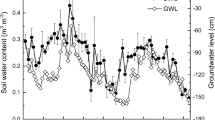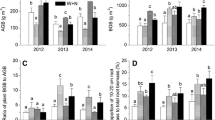Abstract
The quantification of root turnover is necessary for a complete understanding of plant carbon (C) budgets, especially in terms of impacts of global climate change. To improve estimates of root turnover, we present a method to distinguish current- from prior-year allocation of carbon (C) to roots in global change experiments by using changes in 13C:12C ratios (δ13C values) resulting from application of 13C-depleted, tank-derived CO2. In a 4-year study examining effects of elevated CO2 and temperature on reconstructed Douglas-fir (Pseudotsuga mensiezii) ecosystems, δ13C patterns of fine roots and foliage were measured yearly. Native soil of low nitrogen (N) content was used, so plant N supply relied on natural soil N processes. Under these N-limited conditions, elevated CO2 or temperature did not affect the proportion of fine root C derived from current-year photosynthate. Regression analyses showed that 75% of fine root C originated from current-year photosynthate. The method is useful as an independent measure of the contribution of current-year photosynthate to root C and could be used to improve estimates of root C budgets with concurrent measurements of root C pools. We calculated a 13C enrichment of root C relative to foliar C of 2‰. This enrichment agrees with prior measurements of the enrichment of heterotrophic versus autotrophic plant tissues and must be accounted for when using shifts in foliar δ13C to calculate inputs of plant C into the soil. This enrichment probably contributes to the progressive enrichment in 13C with increasing depth in soil profiles.
Similar content being viewed by others
References
Abacus Concepts 1996 Statview Reference. Abacus Concepts, Inc, Berkeley, California.
Balesdent J and Balabane M 1996 Major contribution of roots to soil carbon storage inferred from maize cultivated soils. Soil Biol. Biochem. 28, 1261–1263.
Bolinder M A, Angers D A, Giroux M and Laverdière MR 1999 Estimating C inputs retained as soil organic matter from corn (Zea Mays L.). Plant Soil 215, 85–91.
Cheng C and Johnson D W 1998 Elevated CO2, rhizosphere processes, and soil organic matter decomposition. Plant Soil 202, 167–174.
Cheng W, Sims D A, Luo Y, Johnson D W, Ball J T and Coleman J S 2000 Carbon budgeting in plant-soil mesocosms under elevated CO2: locally missing carbon? Global Change Biol. 6, 99–109.
Ehleringer J R, Buchmann N and Flanagan L B 2000 Carbon isotope ratios in belowground carbon cycle processes. Ecol. Appl. 10, 412–422.
Ericsson A and Persson H 1980 Seasonal changes in starch reserves and growth of fine roots of 20-year-old Scots pines. In Structure and Function of Northern Coniferous Forests-An Ecosystem Study. Ecol. Bull. 32. Ed T Persson. pp 239–250. Stockholm.
Farquhar G D, Ehleringer J R and Hubick K T 1989 Carbon isotope discrimination and photosynthesis. Ann. Rev. Plant Physiol. Plant Mol. Biol. 40, 503–537.
Gaudinski J B, Trumbore S E, Davidson E A, Cook A C, Markewitz D and Richter D D 2001 The age of fine-root carbon in three forests of the eastern United States measured by radiocarbon. Oecologia 129, 420–429.
Gholz H L, Hendry L C and Cropper W P Jr 1986 Organic matter dynamics of fine roots in plantations of slash pine (Pinus elliotti) in north Florida. Can. J. For. Res. 16, 529–538.
Gill R A and Jackson R B 2000 Global patterns of root turnover for terrestrial ecosystems. New Phytol. 147, 13–31.
Gleixner G, Danier H-J, Werner R A and Schmidt H-L 1993 Correlations between the 13C content of primary and secondary plant products in different cell compartments and that in decomposing basidiomycetes. Plant Physiol. 102, 1287–1290.
Gleixner G, Scrimgeour C, Schmidt H-L and Viola R 1998 Stable isotope distribution in the major metabolites of source and sink organs of Solanum tuberosum L.: a powerful tool in the study of metabolic partitioning in intact plants. Planta 207, 241–245.
Guehl J M, Domenach A M, Bereau M, Barigah T S, Casabianca H, Ferhi A and Garbaye J 1998 Functional diversity in an Amazonian rainforest of French Guyana: a dual isotope approach (? 15N and ? 13C). Oecologia 116, 316–330.
Handley L L, Daft M J, Wilson J, Scrimgeour C M, Ingleby K and Sattar M A 1993 Effects of the ecto-and VA-mycorrhizal fungi Hydnagium carneum and Glomus clarum on the 15N and 13C values of Eucalyptus globulus and Ricinus communis. Plant Cell Environ. 16, 375–382.
Hanson J and Beck E 1994 Seasonal changes in the utilization and turnover of assimilation products in 8-year-old Scots pine (Pinus sylvestris L.) trees. Trees 8, 172–182.
Hobbie E A, Gregg J, Olszyk D M, Rygiewicz P T and Tingey D T in press Effects of climate change on labile and structural carbon in Douglas-fir needles as estimated by ? 13C signatures and Carea measurements. Global Change Biol.
Ineson P, Cotrufo M F, Bol R, Harkness D D and Blum H 1996 Quantification of soil carbon inputs under elevated CO2: C3 plants in a C4 soil. Plant Soil 187, 345–350.
King J S, Pregitzer K S and Zak D R 1999 Clonal variation in aboveand below-ground growth responses of Populus tremuloides Michaux: Influence of soil warming and nutrient availability. Plant Soil 217, 119–130.
Leavitt S W and Long A 1982 Evidence for 13C/12C fractionation between tree leaves and wood. Nature 298, 742–744.
Leavitt, S W and Long A 1991 Seasonal stable-carbon isotope variability in tree rings: possible paleoenvironmental signals. Chem. Geol. 87, 59–70.
Lin G, Ehleringer J R, Rygiewicz P T, Johnson M G and Tingey D T 1999 Elevated CO2 and temperature impacts on different components of soil CO2 efflux in Douglas-fir terracosms. Global Change Biol. 5, 157–168.
Lin G, Ehleringer J R, Rygiewicz P T, Johnson MG and Tingey D T 2001 Time-dependent responses of soil CO2 efflux components to elevated atmospheric [CO2] and temperature in experimental forest mesocosms. Plant Soil 229, 259–270.
Marshall J D and Waring R H 1985 Predicting fine root production and turnover by monitoring root starch and soil temperature. Can. J. For. Res. 15, 791–800.
McLeod A R and Long S P 1999 Free-air carbon dioxide enrichment (FACE) in global change research: a review. Adv. Ecol. Res. 28, 1–56.
Nadelhoffer K J and Fry B 1988 Controls on natural nitrogen-15 and carbon-13 abundances in forest soil organic matter. Soil Sci. Soc. Am. J. 52, 1633–1640.
Olszyk D M and Tingey D T 1996 Environmental modification and shoot growth in a closed ecosystem to evaluate long-term responses of tree seedlings to stress. Acta Hort. 440, 129–134.
Olszyk D M, Wise C, VanEss E and Tingey D 1998 Elevated temperature but not elevated CO2 affects stem diameter and height of Douglas-fir seedlings: results over three growing seasons. Can. J. For. Res. 28, 1046–1054.
Pageau K, Simier P, Naulet N, Robins R and Fer A 1998 Carbon dependency of the hemiparasite Striga hermonthica on Sorghum bicolor determined by carbon isotopic and gas exchange analyses. Aust. J. Plant Physiol. 25, 695–700.
Pate J and Arthur D 1998 ? 13C analysis of phloem sap carbon: novel means of evaluating seasonal water stress and interpreting carbon isotope signatures of folaige and trunk wood of Eucalyptus globulus. Oecologia 117, 301–311.
Poorter H and Nagel O 2000 The role of biomass allocation in the growth response of plants to different levels of light, CO2, nutrients and water: a quantitative review. Aust. J. Plant Physiol. 27, 595–607.
Pregitzer K S, Zak D R, Curtis P S, Kubiske M E, Teeri J A, Vogel C S 1995 Atmospheric CO2, soil nitrogen and turnover of fine roots. New Phytol. 129, 579–585.
Pregitzer K S, King J S, Burton A J and Brown S E 2000 Responses of tree fine roots to temperature. New Phytol. 147, 105–115.
Rasse D P, Longdoz B and Ceulemans R 2001 TRAP: a modelling approach to below-ground carbon allocation in temperate forests. Plant Soil 229, 281–293.
Rygiewicz P T, Johnson M G, Ganio L M, Tingey D T and Storm M J 1997 Lifetime and temporal occurrence of ectomycorrhizae on ponderosa pine (Pinus ponderosa Laws.) seedlings grown under varied atmospheric CO2 and nitrogen levels. Plant Soil 189, 275–287.
Rygiewicz P T, Martin K A and Tuininga A R 2000 Morphological diversity of ectomycorrhizas on Douglas-fir (Pseudotsuga menziesii Mirb. Franco) seedlings grown under elevated atmospheric CO2 and temperature. Oecologia 124, 299–308.
Scartazza A, Lauteri M, Guido M C and Brugnoli E 1998 Carbon isotope discrimination in leaf and stem sugars, water-use efficiency and mesophyll conductance during different developmental stages in rice subjected to drought. Aust. J. Plant Physiol. 225, 489–498.
Schweizer M, Fear J and Cadisch G 1999 Isotopic (C-13) fractionation during plant residue decomposition and its implications for soil organic matter studies. Rapid Comm. Mass Spec. 13, 1284–1290.
Syvertsen J P, Smith M L, Lloyd J and Farquhar G D 1997 Net carbon dioxide assimilation, carbon isotope discrimination, growth, and water-use efficiency of Citrus trees in response to nitrogen status. J. Amer. Soc. Hort. Sci. 122, 226–232.
Terwilliger V J and Huang J 1996 Heterotrophic whole plant tissues show more 13C enrichment than their carbon sources. Phytochemistry 43, 1183–1188.
Tierney G L and Fahey T J 2001 Evaluating minirhizotron estimates of fine root longevity and production in the forest floor of a temperate broadleaf forest. Plant Soil 229, 167–176.
Tingey D T, McVeety B D, Waschmann R, Johnson M G, Phillips D L, Rygiewicz P T and Olszyk D M 1996 A versatile sunlit controlled-environment facility for studying plant and soil processes. J. Env. Qual. 25, 614–625.
Tingey D T, Phillips D L and Johnson M G 2000 Elevated CO2 and conifer roots: effects on growth, life span and turnover. New Phytol. 147, 87–103.
Author information
Authors and Affiliations
Rights and permissions
About this article
Cite this article
Hobbie, E.A., Tingey, D.T., Rygiewicz, P.T. et al. Contributions of current year photosynthate to fine roots estimated using a 13C-depleted CO2 source. Plant and Soil 247, 233–242 (2002). https://doi.org/10.1023/A:1021580232181
Issue Date:
DOI: https://doi.org/10.1023/A:1021580232181




